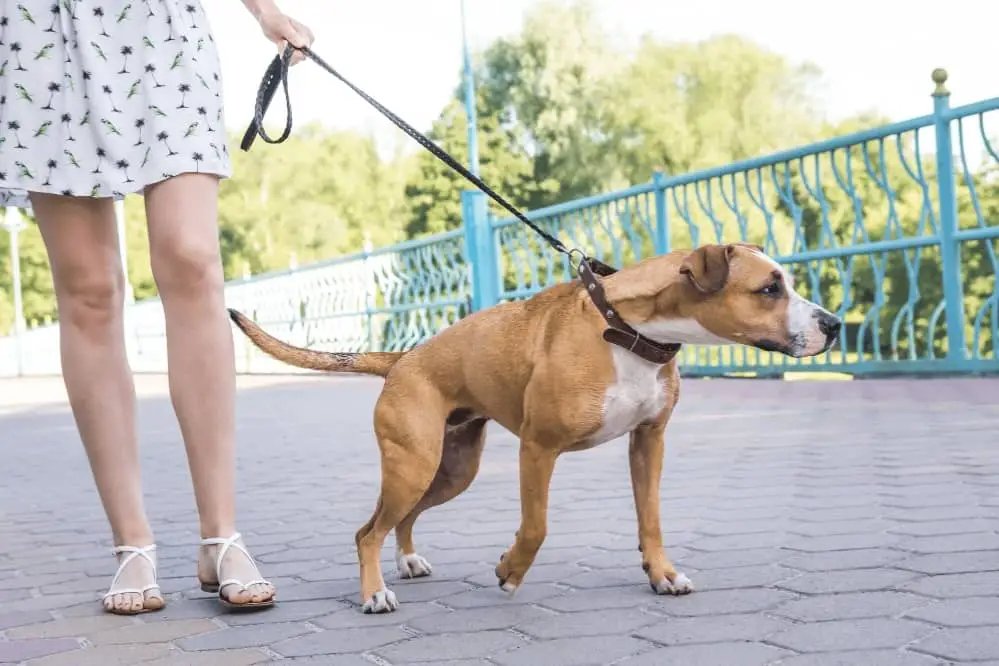Walking your dog without it pulling on the leash is already hard enough as is. Now, factor in that you have an energetic and excitable dog that really wants to play with other dogs. Stopping a dog from pulling on the leash when it sees another dog is much harder than just getting it to stop pulling in general.
Dogs get excited, they like to play, and they will want to interact with other dogs, especially if there are no other dogs in the home where they live. Let’s go over some crucial tips on how to stop a dog from pulling when it sees another dog.
Take a Step Back from Other Dogs
One of the things that will make your dog pull towards other dogs when walking is if you walk near other dogs. The closer your dog is to other dogs, the stronger its desire will be to get to those other dogs, so take a step back.
The more your dog pulls, the closer it gets to the other dogs, which is like a reward for it. Therefore, walking near other dogs is not going to help, and is actually the start of creating a cycle. The closer your dog is to other dogs, the more it pulls, the closer it gets to other dogs.
Moreover, when this happens, you as the owner will probably feel the need to take increased steps to correct the behavior, such as yelling at the dog and pulling it backwards.
Yelling at your dog will get you nowhere and yanking back on the leash will actually cause a dog to pull harder. If you fight the dog, it will fight you back. It’s best to walk your dog away from other dogs.
Dog Classes
Perhaps the best way to get your dog to stop yanking on the leash when it sees another dog is to take your dog to some high-quality training classes.
Your dog is much less likely to engage in this kind of behavior when it views you as the pack leader. The more you train your dog to obey various commands, the more used to those commands it will get.
Moreover, constantly training your dog and forcing it to listen to commands will also make the dog view you as the pack leader.
If your dog is obedient and views you as the pack leader, it’s going to be much less likely to pull on the leash when it sees other dogs. In other words, it will heel or sit when you tell it to, as opposed to ignoring your commands.
Watch Me + Rewards
A proven way to get your dog to stop pulling on the leash when they see other dogs is to get them to watch you. By taking their attention away from the other dogs, and focusing that attention on you, they will stop pulling immediately. A good way to go about this is to make some kind of noise with your mouth. At first, this noise, such as the smacking of your lips, will be meaningless to the dog.
However, the second step is to take a treat and hold it close to your eyes. Do this right after you make the sound. This will encourage the dog to look at your eyes, instead of focusing on the other dogs. You want to use treats to do this, especially when then dog is still in the learning phase.
Food is always a great motivator for dogs. You can then keep increasing the duration of the eye contact. What is important is that you start doing this on a quiet street without distractions. Your dog needs to get used to this. If you try this method for the first time in front of other dogs, it probably won’t work.
The Reward Method
It is also very important that at some point, you let the dog interact with the other dogs. However, this needs to be on your terms. If the dog pulls on the leash, don’t let it to the other dogs. If you do, this will just encourage the bad behavior.
However, if you manage to the get “watch me” method down, or your dog actually sits when you tell it to, you should then let the dog to the other dogs. This will encourage the good behavior.
By allowing your dog to interact with the others after following your commands, it reinforces that behavior. It’s all about a command and reward structure.
Conclusion
Try any one of the above methods to get the dog to stop pulling when it sees other dogs. If one method doesn’t work, try the next, or a combination of them. Remember that none of these methods are going to work the first time — you need to be patient and consistent.

